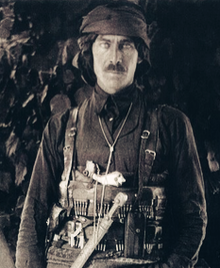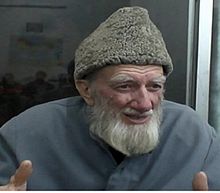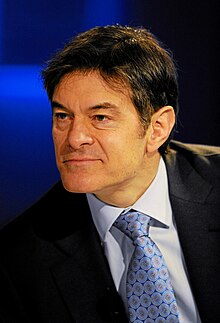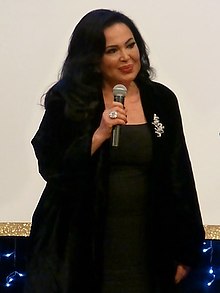
The Circassians or Circassian people, also called Cherkess or Adyghe are a Northwest Caucasian ethnic group and nation who originated in Circassia, a region and former country in the North Caucasus. As a consequence of the Circassian genocide, which was perpetrated by the Russian Empire during the Russo-Circassian War in the 19th century, most of the Circassian people were exiled from their ancestral homeland and consequently began living in what was then the Ottoman Empire—that is, modern-day Turkey and the rest of the Middle East. In the early 1990s, the Unrepresented Nations and Peoples Organization estimated that there are as many as 3.7 million Circassians in diaspora in over 50 countries.

Anzavur Ahmed Anchok Pasha was an Ottoman soldier, gendarme officer, pasha, and militia leader of Circassian origin. He was declared a pasha by the late Ottoman government.

The Circassian genocide, or Tsitsekun, was the Russian Empire's systematic mass murder, ethnic cleansing, and expulsion of 95–97% of the Circassian population, resulting in 1 to 1.5 million deaths during the final stages of the Russo-Circassian War. The peoples planned for extermination were mainly the Muslim Circassians, but other Muslim peoples of the Caucasus were also affected. Killing methods used by Russian forces during the genocide included impaling and tearing the bellies of pregnant women as means of intimidation of the Circassian population. Russian generals such as Grigory Zass described the Circassians as "subhuman filth", and glorified the mass murder of Circassian civilians, justified their use in scientific experiments, and allowed their soldiers to rape women.
The Abzakh are one of the twelve major Circassian tribes, representing one of the twelve stars on the green-and-gold Circassian flag. Historically, they lived in the mountainous part of the modern Russian republics of Adygea and Krasnodar Krai. Major settlements or villages were located in the river valleys Kurdzhips, Psheha, Pshish, and Psekups.

The Russo-Circassian War, also known as the Russian invasion of Circassia, was the invasion of Circassia by Russia, starting in 1763 (O.S) with the Russian Empire assuming authority in Circassia, followed by the Circassian refusal, and ending 101 years later with the last army of Circassia defeated on 21 May 1864 (O.S), making it exhausting and casualty-heavy for both sides. The Russo-Circassian War was the longest war both Russia and Circassia have ever fought and the longest war in the Caucasus region.

Çerkes Ethem, known in English as Ethem the Circassian, was a Circassian Ottoman guerilla leader, social bandit, efe and soldier. He initially gained fame for establishing the Kuva-yi Seyyare and putting down multiple large-scale rebellions and gaining key major victories against the Greek armies invading Anatolia during the Turkish War of Independence.
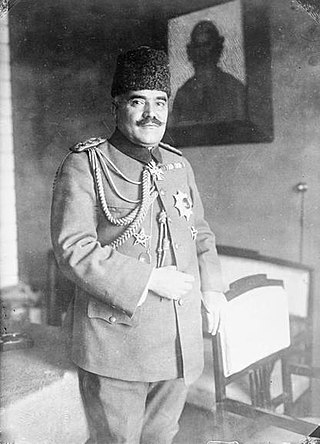
Zeki Pasha, known as Mehmet Zeki Baraz Kolaç Kılıçoğlu after the 1934 Surname Law, was an Ottoman Balkan Wars and World War I field marshal of the Ottoman Army. He was of Circassian descent.
Pasha was a high rank in the Ottoman political and military system, typically granted to governors, generals, dignitaries, and others. Pasha was also one of the highest titles in the 20th-century Kingdom of Egypt and it was also used in Morocco in the 20th century, where it denoted a regional official or governor of a district.

Circassians in Turkey refers to people born in or residing in Turkey that are of Circassian origin. The Circassians are one of the largest ethnic minorities in Turkey, with a population estimated to be two million, or according to the EU reports, three.

The Circassian diaspora refers to ethnic Circassian people around the world who live outside their homeland Circassia. The majority of the Circassians live in the diaspora, as their ancestors were settled during the resettlement of the Circassian population, especially during the late nineteenth and early twentieth century. From 1763 to 1864, the Circassians fought against the Russian Empire in the Russian-Circassian War, finally succumbing to a scorched-earth genocide campaign initiated between 1862 and 1864. Afterwards, large numbers of Circassians were exiled and deported to the Ottoman Empire and other nearby regions; others were resettled in Russia far from their home territories. Circassians live in more than fifty countries, besides the Republic of Adygea. Total population estimates differ: according to some sources, some two million live in Turkey, Jordan, Syria, and Iraq; other sources say between one and four million live in Turkey alone.
The Abaza rebellion is the name given to uprisings that occurred in the 17th century in the Ottoman Empire during the reigns of Mustafa I (1622–23) and Murat IV (1623–40). The name of the rebellion refers to Abaza Mehmet, an Ottoman pasha of Abkhazian origin. Sometimes, this event is considered as a part of the Jelali revolts. But unlike the other Jelali revolts the principal reason of the Abaza rebellion was the resentment towards the janissary corps.
Ahmet Fevzi Big or Ahmet Fevzi Paşa (1871-1947) was an Ottoman commander of the Ninth Army Corps of the Ottoman Third Army. He was an Abkhazian immigrant from Düzce. He was from the Circassian Big family. His father's name was Yakub.

Hajji Kizbech Tughuzhuqo was a Circassian military commander who took part in the Russo-Circassian War. Personally witnessing all of his family get killed by the Russian army, Tughuzhuqo was a cavalry commander especially successful in raiding behind enemy lines. He received multiple offers from the Russian Empire to switch sides and join its Imperial ranks but he refused all offers and closed negotiations. The Englishman James Bell, who knew him personally, called him "The Lion of Circassia".
The Circassians in Iran are an ethnic minority in Iran. Circassians in Iran differ somewhat from other Circassian diasporas, in that most in the former stem from the Safavid and Qajar era, although a number migrated as muhajirs in the late 19th century as well. The Circassians in Iran were very influential during periods in the last few centuries. The vast majority of them have assimilated to speak the Persian language, and no significant number speak their native Circassian languages anymore. Once a very large minority in Iran, nowadays due to being heavily assimilated over the course of time and the lack of censuses based on ethnicity, population estimates vary significantly. They are, however, after the Georgians, known to be the largest Caucasus-derived group in the nation.

The Circassians in Egypt are people of Egypt with Circassian origin. For centuries, Circassians have been part of the ruling elite in Egypt, having served in high military, political and social positions. The Circassian presence in Egypt traces back to 1297 when Lajin became Sultan of Mamluk Sultanate of Egypt. Under the Burji dynasty, Egypt was ruled by twenty one Circassian sultans from 1382 to 1517. Even after the abolishment of the Mamluk Sultanate, Circassians continued to form much of the administrative class in Egypt Eyalet of Ottoman Empire, Khedivate of Egypt, Sultanate of Egypt and Kingdom of Egypt. Following the Revolution of 1952, their political impact has been relatively decreased.
Abaza Hasan Pasha, also called Kara Hasan Pasha or Celali Hasan Pasha;, was an Ottoman provincial governor and celali rebel of the mid-seventeenth century. He launched two rebellions against the Ottoman government, the second and largest of which ended with his assassination in Aleppo on 16 February 1659 following a failed attempt to force the deposition of the Grand Vizier Köprülü Mehmed Pasha.

Seferbiy Zaneqo or Sefer Pasha was a Circassian diplomat and military commander who served as the 5th leader of the Circassian Confederation from 1859 to 1860. He took part in the Russo-Circassian War both in a military and a political capacity. Advocating for the Circassian cause in the west and acting as an emissary of the Ottoman Empire in the region. By the end of his life Zaneqo had emerged as the leader of the Circassian resistance.

Kuvâ-yi Seyyâre, also known as the Green Army Society or the People's Branch was a force of Circassian and Abkhazian volunteers led by Çerkes Ethem against the Allied invasion forces during the Turkish War of Independence. The group saw themselves as a force to fight against "those who caused disturbance to the greater good of Anatolia". The forces put down several rebellions and played a big role in significantly slowing down the Greek army during the Greco-Turkish War (1919-1922). In time, as Ethem's Islamic Socialist views clashed with the Turkism-nationalism of Mustafa Kemal's Turkish National movement, he eventually cut ties with them, and was declared a traitor due to clashes with İsmet İnönü.
Hayriye-Melech Xhundj was a Circassian writer and teacher. She is considered one of the first Circassian female writers.
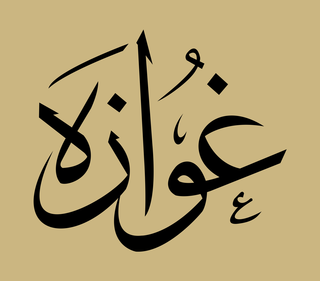
The Circassian Union and Charity Society or Çerkes İttihat ve Teavün Cemiyeti was a Circassian nationalist charitable organization in the Ottoman Empire. It was based on several principles, mainly intellectualism, Circassian nationalism, and belief in Islam.


